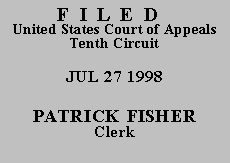

| PAUL C. ALBERTS, |
No. 98-8002 |
| v. |
(D. Wyoming ) |
| DUANE SHILLINGER, Warden of the Wyoming State Penitentiary; WYOMING ATTORNEY GENERAL, |
(D.C. No. 93-CV-230) |
Paul C. Alberts, a state prisoner, filed a petition pursuant to 28 U.S.C. § 2254 in August 1993. The district court denied Alberts' petition on the merits, and Alberts appeals. We construe his notice of appeal as an application for a certificate of probable cause.(1)
Alberts is not entitled to a certificate of probable cause unless he can make a substantial showing of the denial of a federal right. See Lozada v. Deeds, 498 U.S. 430, 431-32 (1991); Barefoot v. Estelle, 463 U.S. 880, 893 & n.4 (1983), overruled in part on other grounds by Lindh v. Murphy, 117 S. Ct. 2059 (1997). Having reviewed the district court's Orders of March 4, 1996 and January 14, 1998, as well as the appellate briefs and record on appeal, we conclude that there is no error in the district court's decisions. Therefore, for substantially the reasons stated by the district court, we conclude that Mr. Alberts has failed to make a substantial showing of the denial of a federal right.
Accordingly, we DENY Alberts a certificate of probable cause, and DISMISS the appeal.(2)
ENTERED FOR THE COURT
Stephen H. Anderson
Circuit Judge
*.This order and judgment is not binding precedent, except under the doctrines of law of the case, res judicata, and collateral estoppel. The court generally disfavors the citation of orders and judgments; nevertheless, an order and judgment may be cited under the terms and conditions of 10th Cir. R. 36.3.
1.Because Alberts filed his habeas petition before the enactment of the Antiterrorism and Effective Death Penalty Act of 1996 ("AEDPA"), the AEDPA's requirements do not apply to this appeal. See United States v. Kunzman, 125 F.3d 1363, 1364 n.2 (10th Cir. 1997), cert. denied, 118 S. Ct. 1375 (1998). Instead, we apply the pre-AEDPA requirements and construe his notice of appeal as a request for a certificate of probable cause. See Hernandez v. Starbuck, 69 F.3d 1089, 1090 n.1 (10th Cir. 1995); Fed. R. App. P. 22(b) (prior to enactment of the AEDPA).
2.Although we dispose of this appeal on other grounds, there are good reasons to believe that Mr. Alberts' petition is successive or abusive, or both. Since his conviction in 1981 of aggravated robbery, assault, child stealing, and felony murder, Alberts has spent the last seventeen years litigating in various forums. Our inquiries at the clerk's office reveal that he has previously filed at least one petition pursuant to 28 U.S.C. § 2254. This earlier petition, which challenged, inter alia, the pretrial identification procedures, was ultimately denied on the merits. See Alberts v. Shillinger, No. C85-0328B (D. Wyo. May 1, 1986). On appeal, this court denied Mr. Alberts a certificate of probable cause. Alberts v. Shillinger, No. 86-1806 (10th Cir. Sept. 11, 1986). Seven years later, Alberts filed the instant petition, which the district court also denied on the merits. In this petition, Alberts again challenges the pretrial identification procedures; he also raises several new issues.
Under Rule 9(b) of the Rules Governing Section 2254 Proceedings, a judge may dismiss a second or successive petition if "it fails to allege new or different grounds for relief and the prior determination was on the merits or, if new and different grounds are alleged, the judge finds that the failure . . . to assert those grounds in a prior petition constituted an abuse of the writ." See also 28 U.S.C. § 2244. A review of the limited record provided to this court reveals that Alberts' argument regarding the pretrial identification procedures may be sufficiently similar to arguments raised in his prior § 2254 petition to bar review of that claim in a successive petition. See Sanders v. United States, 373 U.S. 1, 15 (1963); Andrews v. Deland, 943 F.2d 1162, 1171-72 (10th Cir. 1991). In addition, the remaining claims which Mr. Alberts raises here, but which he did not raise in his earlier petition, may constitute an abuse of the writ. See McCleskey v. Zant, 499 U.S. 467, 492-94 (1991); United States v. Richards, 5 F.3d 1369, 1370 (10th Cir. 1993).
Inexplicably, neither the government nor the district court addressed this issue. We recognize that the government bears the burden of pleading abuse of the writ. See McCleskey, 499 U.S. at 477. Nevertheless, the district court could have raised the issue sua sponte, as long as it also gave Alberts notice and an adequate opportunity to respond. See Williams v. Whitley, 994 F.2d 226, 231-32 (5th Cir. 1993); United States v. Fallon, 992 F.2d 212, 213 (8th Cir. 1993); see also Harris v. Champion, 48 F.3d 1127, 1132 n.4 (10th Cir. 1995); cf. Hardiman v. Reynolds, 971 F.2d 500, 502-03 (10th Cir. 1992) (concluding federal courts possess the power to raise nonjurisdictional matters sua sponte in a habeas corpus proceeding because these doctrines implicate values "that transcend the concerns of the parties to an action").